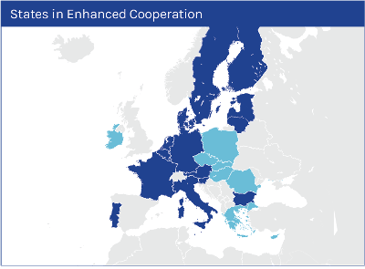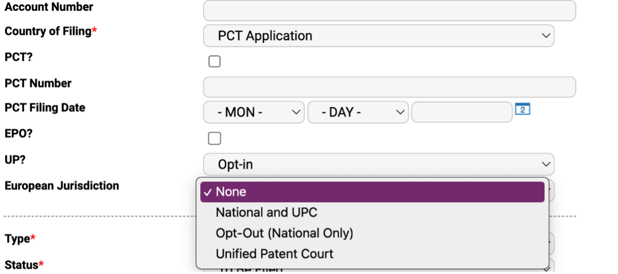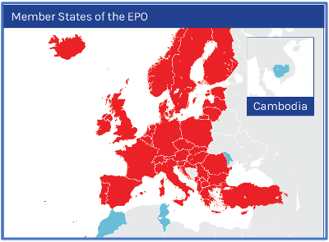As the Sunrise Period has recently ended, clients continue to express an interest in better understanding the options and implications of applying for a Unitary Patent (UP) and how their existing European Patents (EP) if not proactively opted out, will be under the dual jurisdiction of the Unified Patent Court (UPC) and national courts.
The purpose of this blog post is to guide you through the differences between UP, UPC, and EP and to showcase important considerations that go towards choosing a specific type of patent and a specific type of jurisdiction.
What is the difference between the UP and the UPC?
The UP stands for the Unitary Patent and refers to the new patent that can be obtained after the grant of a European Patent application and gives protection in 17 territories.
These territories (shown in dark blue on the map) are Austria, Belgium, Bulgaria, Denmark, Estonia, Finland, France, Germany, Italy, Latvia, Lithuania, Luxembourg, Malta, the Netherlands, Portugal, Slovenia, and Sweden. 
While the 17 territories (in dark blue) are the ones that have currently ratified the Unified Patent Court Agreement (UPCA), this Agreement is expected to extend to a total of 25 countries in the future, covering the countries shown in light blue on the map above to become the States in the Enhanced Cooperation.
The UPC stands for the Unified Patent Court and refers to the court that has jurisdiction over all Unitary Patents and UP claims and over older national validations in the 17 territories that have currently signed the Unified Patent Court Agreement. Therefore, the UPC’s jurisdiction covers all Unitary Patents and related matters, as well as previously granted European Patents validated in UP territories. These latter national validated patents currently straddle in a passive manner across ‘dual jurisdictions’ as an action can be brought in either the UPC or the national court unless the patent owners actively opt out or until a jurisdiction is forcibly established through the start of proceedings in one of the courts.
What is opting out?
An opt-out refers to a proactive request for a published European Patent or a national validation to be excluded from the UPC’s jurisdiction. If patent owners do not take the action to opt-out from the Unified Patent Court's jurisdiction, the already granted European Patents (i.e. the cases validated in countries that have ratified the UPCA), are vulnerable to a third party bringing an action against them in the UPC. This will give the UPC sole and exclusive jurisdiction, thereby putting an end to the dual jurisdiction possibilities. Once an action is brought against a patent in the UPC, the owners will no longer be able to opt out of UPC's jurisdiction, in respect of that patent. However, once an opt-out is complete, owners can opt back in later if they change their minds. Understandably, there is no option for a second opt-out after that.
Here are some considerations for opting out:
- For an opt-out to be complete, all patent owners must approve the process, making it important for current ownership over patents to be clearly checked and confirmed.
- The result proceedings in the UPC are universally applicable across all UPCA territories. As such, if a patent right is extinguished in one of the UPCA territories, it is extinguished in all the territories.
- Precedents in the UPC are yet to be established, meaning there is little information on how cases will be decided.
How do you keep track of the cases you have opted out from?
- Wellspring has added additional fields in Sophia to help you keep track of the jurisdictional aspects of your cases.
- The new drop-down menu includes options for UPC's jurisdiction as follows:
- Opt-Out (National Only): for cases opted out from under the UPC’s jurisdiction and that will remain under the jurisdiction of the respective national courts only.
- UPC: if the granted European case(s) all fall under the UPC’s jurisdiction (i.e. EP validations without opt-outs or UP cases)
- National and UPC: where the European Patent application resulted in UP and national validations in countries outside the scope of the UPC’s jurisdiction or where the patent family is composed of UP and non-UP cases.

What is the difference between UP and EP?
When considering your European IP strategy going forward it is important to understand the difference between securing a Unitary Patent when your EP application grants, what geographic cover it offers, and the IP protection it provides. 
The Unitary Patent is a singular patent with a singular universal yearly renewal fee (as opposed to 17 renewal fees for 17 territories). However, it is important to note that there are 39 member states of the EPO. This means that applicants going down the Unitary Patent route would not have protection in countries and key markets like the United Kingdom, Spain, or Switzerland.
Importantly, there is the possibility to secure a Unitary Patent alongside national validations in non-UP territories, upon the grant of a European Patent application. As such, the Unitary Patent will be under the UPC's jurisdiction, while the national validations will be under the jurisdiction of their own national courts, working alongside each other.
What next?
This article explains how a Unitary Patent gives protection across the UPCA territories however it is important to note that if challenged and extinguished in one UPCA territory all 17 territories are affected.
Therefore, the UP approach and strategy pull in commercial, legal, and economic considerations that need to be weighed up before determining a default position or framework for assessing how to proceed when your EP application is granted. Seek legal and IP advice from your Patent Attorneys and look at Wellspring’s tools and services, such as Scout and Sophia to inform these considerations to shape your IP and commercialisation strategy. If you do need additional assistance or have questions regarding the use of Sophia or Scout to document your choices, please submit a ticket via the Help Center to Wellspring's Client Services team.
